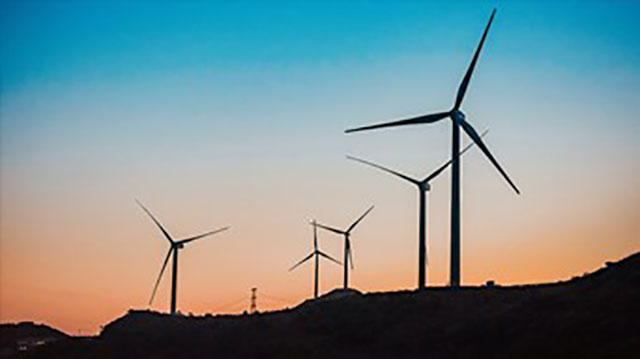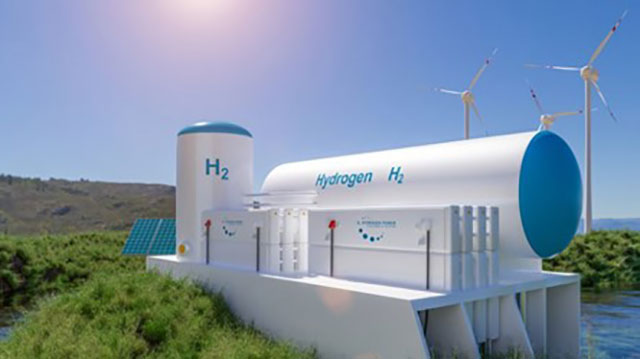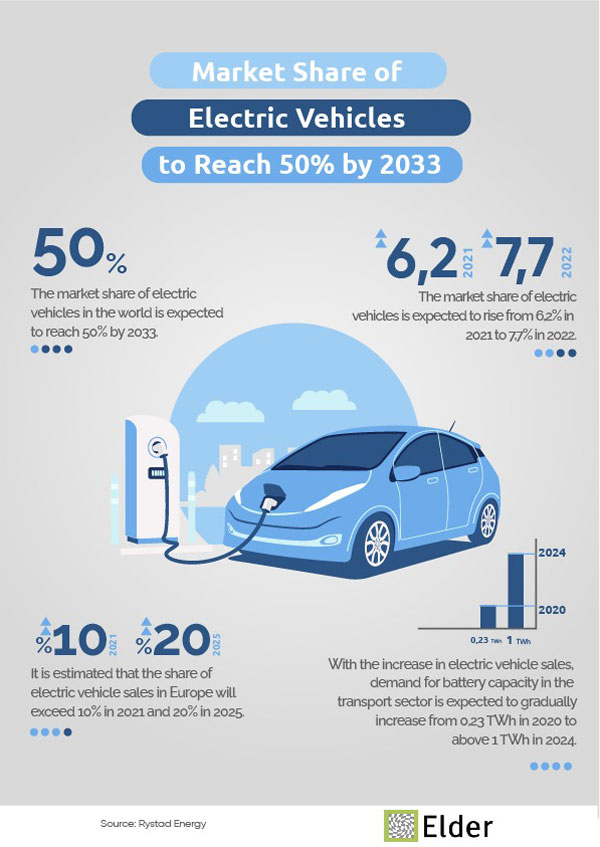
Turkey has invested $635 million in energy efficiency last year, helping save 451,000 tons of oil equivalent valued at $158 million, according to Turkey's Energy and Natural Resources Minister on Wednesday.
Speaking at the Eurasia Cogeneration Conference through video link, Fatih Donmez said that thanks to energy efficiency measures, the industrial sector saved 170,000 tons in final energy demand per year between 2003 and 2018.
"We announced our National Energy Efficiency Action Plan in 2017. With 6 thematic topics and 55 actions, we put a target of a 14% reduction in our primary energy consumption and 66.6 million tons of carbon dioxide equivalent emissions reduction by 2023. We made a total of $4.8 billion in investments for energy efficiency between 2017 and 2020. In return, we made savings of 3.19 million tons of oil equivalent and $1.2 billion cumulatively," he explained.
As part of Turkey’s aim to promote energy efficiency in the industrial sector since 2009, Donmez said that through Efficiency Enhancing Projects, known as VAP, 434 projects valued at 307 million Turkish liras have been launched, some completed and others ongoing with the support of 83 million liras to date. This, in turn, allowed for savings of 90,000 tons of oil equivalent worth 173 million liras.
"We are broadening the scope of VAP to commercial buildings, energy, services and agriculture sector facilities. With the presidential decision in August 2019, a 15% energy efficiency target was set for public institutions up to the end of 2023. Savings have already reached considerable levels," he said.
Turkey plans to invest around $11 billion for energy efficiency in all related sectors by 2023 in line with the National Energy Efficiency Action Plan.
The country foresees savings of $30 billion by 2033 thanks to these investments and by invoking the 55 action points to develop energy efficiency measures throughout various sectors, including industry, transport, construction, agriculture, and energy generation and transformation.
Source: Anadolu Agency

Turkey will be blending hydrogen, promoted as a clean, efficient and sustainable energy source, with natural gas with the new facility established in the central province of Konya.
The Center For Clean Energy Technologies is due to be opened Friday by Energy and Natural Resources Minister Fatih Donmez. The facility was established by the Natural Gas Distributors Association (GAZBIR) Technical Center Gazmer. Blending hydrogen into the natural gas network is known as having benefits for energy storage, resiliency and emissions reductions. Hydrogen can be injected into natural gas pipelines, and the blend can then be used by conventional end-users of natural gas to generate power and heat.
Turkish households will be provided cleaner energy with the facility that will mark a first for Turkey. Speaking ahead of the opening, Donmez said hydrogen would be injected into natural gas at a certain rate, thus boosting its performance. The new form of clean energy will be spread throughout Turkey in the medium-term, the minister noted. The latest move comes as part of Turkey’s quest for alternative resources to lower its external energy dependency.
The research and development (R&D) studies at the center are expected to reduce both carbon density as well as natural gas imports. Turkey has the sixth largest natural gas distribution network in Europe with a length of around 156,000 kilometers (96,900 miles). Natural gas is being used across 81 provinces. Some 82% of the population benefits from the current natural gas network. The country’s annual natural gas consumption hovers around 45 billion cubic meters (bcm).
Source: Daily Sabah

Norway’s $1.3tn oil fund has made its first investment in renewable infrastructure, shrugging off concern about the recent prices paid for wind power projects, as its chief executive said he wanted to “tune up” returns at the world’s largest sovereign wealth fund.
The oil fund on Wednesday said it would pay €1.4bn for a 50 per cent stake in a Dutch offshore wind farm owned by Orsted, the Danish renewable energy giant that will remain operator of the project. Under its mandate from Norway’s parliament, the fund can invest up to NKr120bn ($14.2bn) in renewable infrastructure. It is seeking to become one of the world’s biggest such investors as it diversifies its portfolio away from equities, bonds and property.
“We think we have a competitive advantage in that we’re a large fund that can write a large cheque. This is an area where we see a lot of opportunities going forward. For the fund, we see the diversification it can give us,” Mie Holstad, chief real assets officer at the fund’s manager, told the Financial Times. Norway has diverted its petroleum revenues into the fund for more than a quarter of a century, building up the world’s largest sovereign wealth investor that until recently only owned public securities.
In the past decade, it has become one of the world’s largest property investors, owning large swaths of prime real estate in cities such as London, New York and Tokyo, as well as logistics buildings. The fund has been able to invest in wind and solar power projects since the start of 2020, and Holstad said it had looked at eight potential projects last year.
It took part in one auction for a renewable energy asset but dropped out. Mads Nipper, the new chief executive of Orsted, told the FT earlier this year that the very high prices paid in a UK auction of offshore wind — since replicated in other projects — by oil majors meant that the energy source could become less competitive.
Others have warned that the prices paid by companies were nearing bubble territory. Following decisions to increase its equity share in 1998, 2007 and 2019 shortly before market crashes, the oil fund gained a reputation as something of a contrarian indicator. Asked whether that could be the case too with renewable infrastructure, chief executive Nicolai Tangen said he was not worried that its investments would be at “peak levels”.
He added: “It’s not like we have to deploy all the money in 10 minutes. We have time to find the right investments. We’re pretty sure that demand for these type of renewable infrastructure assets will increase.”
The fund specified that it was looking for assets that had “reduced power price risk, stable cash flow, and limited risk to the principal investment”. Separately, the fund released a revised strategy for the next two years, the first unveiled under Tangen, a former hedge fund boss. The fund said it would increase its “active positioning” around mergers and other events as well as boosting its research on what it termed “negative selection” through use of forensic accounting to sell companies “we expect to underperform”.
However, Tangen denied that the fund was becoming more activist and adopting hedge fund-like strategies. He said the new approach was a “combination of tuning up a bit what has worked well” such as risk-based divestments, and bringing in new ideas such as an investment simulator that tries to help fund managers learn from their mistakes, and an increased focus on mental resilience.
Source: Financial Times

A record amount of renewable energy capacity was built last year, thanks largely to investments in China and the U.S., according to the International Renewable Energy Agency.
Renewables -- mostly in the form of wind and solar -- accounted for 82% of new electricity installation in 2020, said Abu Dhabi-based Irena, which advises governments on clean power. China added 136 gigawatts, more than half the total and a similar amount to Spain’s overall power production.
“These numbers tell a remarkable story,” said Irena Director General Francesco La Camera. “Despite the difficult period, as we predicted, 2020 marks the start of the decade of renewables. Costs are falling, clean tech markets are growing and never before have the benefits of the energy transition been so clear.”
Renewables still lag dirtier forms of electricity generation, with their share of total capacity rising two percentage points from 2019 to 36.6%, Irena said in a report. The organization said there was still “a huge amount to be done.”
Decarbonization to limit the worst effects of climate change will require a 10-fold expansion in renewable energy through 2050, or investment of $4.4 trillion a year, Irena said earlier this month. China, which is both the largest market for clean power and the world’s biggest polluter, built 72 GW of wind energy and 49 GW of solar in 2020, according to Monday’s report. The U.S. installed 29 GW of renewables, almost 80% more than in 2019. While renewable capacity grew, there was a net decommissioning of fossil-fuel power generation in Europe, North America and nations such as Russia and Turkey, the report said. Total fossil fuel additions fell to 60 GW in 2020 from 64 GW the previous year, it said.
Source: Bloomberg

If electric vehicles are part of the Biden infrastructure plan, that’s a big deal—for both car buyers and the auto companies. And the biggest winner would be the biggest EV maker, Tesla.
Right now, the government gives a tax credit of $7,500 for a car. There’s a catch, though: Each manufacturer has a cap of 200,000 EVs sold in the U.S. If they sell more than that, a buyer can’t get the deduction. For example, Nissan hasn’t sold 200,000 of, say, its Leaf EVs, so a buyer gets the deduction. The same is true for other EV makers—the deduction is still available—except two: Tesla (ticker: TSLA) and General Motors (GM).
GM supports the tax credit—and getting rid of the cap. In an essay on LinkedIn, President Mark Reuss pushed for “smart and effective public policy”.
He focused on three key points: investment in fast-charging stations, which would boost consumer confidence in EVs; buyer incentives, including “a modification to the EV tax credit so that customers of first movers like GM are not penalized, and one that makes used EV buyers eligible;” and investment tax credits so companies can build more EV plants in the U.S.
Early on, analysts figured Biden’s plan would lift the cap but keep the credit amount at $7,500. Now, they’re thinking no cap and a $10,000 credit, which would be what Wedbush analyst Dan Ives describes as “a goldilocks scenario in the eyes of the Street” and a spark plug for the sector.
Morgan Stanley’s Adam Konas is telling investors to get ready for “an EV infrastructure bill—including purchase incentives for EVs.” A new federal push wouldn’t only be good for Tesla and the legacy auto makers like GM but EV start-ups like Lucid Motors. Still, for Jonas, the biggest winner would be Tesla. “Put it all together and we believe auto investors face a greater risk of not owning Tesla shares.” Both Ives and Jonas are Tesla bulls, rating shares Buy. Ives’ target price $1,000. Jonas has an $880 target price.
Source: Barrons

European energy ministers have highlighted the need to create a stable regulatory framework for hydrogen in the European Union, capable of attracting private investors into a competitive and predictable market.
Speaking at the conference “Hydrogen in Our Societies – Building Bridges” on Wednesday (7 April), a number of national politicians expressed the same point.
“Public and private investment should ally, and governments have the responsibility to give the right signals, creating the regulatory framework and conditions for the private sector to invest with stability and predictability,” said Portugal’s minister of environment and climate action, João Pedro Matos Fernandes. Along the same line, Dutch minister of economic affairs and climate policy, Bas van’t Wout, also highlighted the importance of mobilising public sector investment, which he said it would be crucial for implementing the European strategy for hydrogen as a key element in the decarbonisation of sectors of the economy where other alternatives “may not be viable or be more expensive”.
Meanwhile, Elisabeth Winkelmeier-Becker of the German federal ministry of economic affairs and energy said that besides the regulatory framework, it was also crucial to plan the necessary infrastructure for the production and distribution of hydrogen (obtained through the electrolysis of water, which separates oxygen from hydrogen). Spain’s secretary of state for energy Sara Aagesen Muñoz added that it was time to accelerate investment and political decisions, laying the foundations for a stable investment.
Claude Turmes, minister of energy and spatial planning of Luxembourg, focused on transparency to attract private investors. “We need a transparent system because private investors will only be interested in moving forward if there is transparency”, Turmes said, emphasising that reducing the cost of electrolysers as one of the most important issues for the future of hydrogen.
Source: Euractiv
How Energy Efficiency Will Power Net-Zero Climate Goals
According to International Energy Agency’s analysis, in the lead-up to COP26, countries around the world are committing to new targets to reach net zero by 2050 or sooner. The energy sector is responsible for three-quarters of global emissions, and transforming it will be critical to tackling the climate crisis. But a “business as usual” approach will do little to achieve change at the scale which is required. Energy efficiency represents more than 40% of the emissions abatement needed by 2040
Please click here to read the full report.
IRENEC 2021 11. International 100 Percent Renewable Energy Conference
20 - 22 May 2021
Eurelectric Power Summit 2021
25 - 28 May 2021
Solarex Istanbul
10 - 12 June 2021
You are My Energy Acceleration Program Demo Day Organization
June 2021
8th International Istanbul Smart Grids and Cities Congress and Expo (ICSG 2021)
04 - 05 June 2021
2021 IEEE PES Futuring the Power Grid
14 - 17 September 2021
Solar Istanbul
22 - 25 September 2021
11. Turkey Energy Summit
10 - 12 October 2021
14. EIF World Energy Congress and Expo
13 - 15 October 2021 / Antalya
European Utility Week (Enlit Europe)
30 November - 2 December 2021

